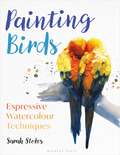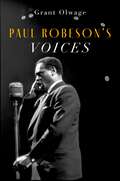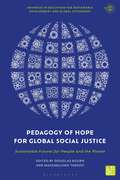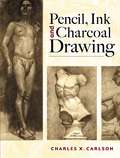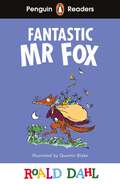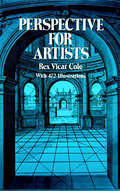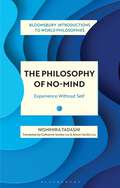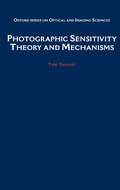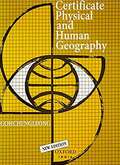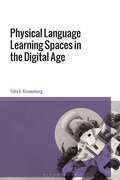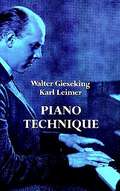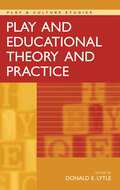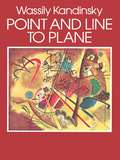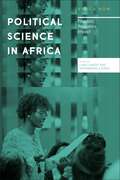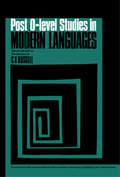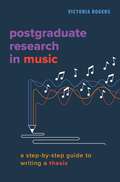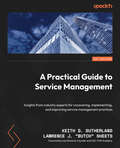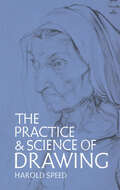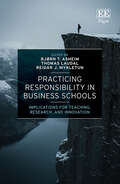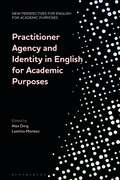- Table View
- List View
Painting Birds: Expressive Watercolour Techniques
by Sarah StokesA guide to capturing the beauty of birds using modern, expressive watercolour painting techniques. Painting watercolours in a loose style is a technique admired by many artists, yet there are a range of skills to master in order to achieve a sense of freedom and lightness of touch. Birds present us with a vibrant array of colours and textures – from the iridescent plumage of the hummingbird to the zingy turquoise blue of the kingfisher – and with such varied and lively characters they are a wonderful subject to paint. Supported by instructional photos throughout, experienced artist Sarah encourages you to let go of the detail whilst providing you with all the techniques required to paint beautiful and characterful portraits of birds with colour and verve. - 10 step-by-step projects accessible to complete beginners and more experienced artists alike. Learn the importance of shape and tone in depicting form. - Discover how watercolour works through experimentation and play with different tools and techniques. - Explore various colour palettes, composition techniques and background basics. - Develop your approach to key features such as feathers, feet, wingspans and faces and other tricky areas such as creating texture, adding shadows and achieving translucency.
Paul Robeson's Voices
by Grant OlwagePaul Robeson's Voices is a meditation on Robeson's singing, a study of the artist's life in song. Music historian Grant Olwage examines Robeson's voice as it exists in two broad and intersecting domains: as sound object and sounding gesture, specifically how it was fashioned in the contexts of singing practices, in recital, concert, and recorded performance, and as subject of identification. Olwage asks: how does the voice encapsulate modes of subjectivity, of being? Combining deep archival research with musicological theory, this book is a study of voice as central to Robeson's sense of self and his politics. Paul Robeson's Voices charts the dialectal process of Robeson's vocal and self-discovery, documenting some of the ways Robeson's practice revised the traditions of concert singing in the first half of the twentieth century and how his voice manifested as resistance.
Pedagogy of Hope for Global Social Justice: Sustainable Futures for People and the Planet (Advances in Education for Sustainable Development and Global Citizenship)
Following Paulo Freire and his concept of pedagogy of hope, this open access book explores the educational role of hope as an approach to learning about global issues in different areas of the world. Climate change, racism, and the COVID-19 pandemic have shown more than ever the need for a global shift in education policy and practice. This book provides a conceptual framework of global education and learning and the role it can play in addressing these social and environmental challenges. Written by scholars based in Australia, Brazil, Canada, China, Ghana, India, Italy, Portugal South Africa, Spain, the UK and the USA, the book addresses a range of local and global issues from global citizenship education in Latin America to training teachers in global education.The ebook editions of this book are available open access under a CC BY-NC-ND 4.0 licence on bloomsburycollections.com. Open access was funded by Knowledge Unlatched.
Pencil, Ink and Charcoal Drawing: Four Volumes Bound as One
by Charles X. CarlsonThis original compilation gathers together four of Charles X. Carlson's finest art instruction books and presents them in one comprehensive volume. A well-known artist, author, and teacher, Carlson offers clear, uncomplicated methods of drawing for aspiring artists at every level. Chock-full of step-by-step illustrations, this compendium expertly covers the fundamentals of drawing figures, portraits, still-lifes, and landscapes for a wide variety of mediums. An all-in-one guide for art students, it includes: Simplified Ink, Pen and Brush Drawing opens the door to a number of drawing techniques, including spattering, stippling, cross-hatching, accented strokes, and the use of chalk and crayon. Simplified Drawing teaches artists the ABCs of free-hand drawing and features the basic principles of an object's construction using the easy "block method." The Simplified Essentials of Charcoal Drawing discusses charcoal materials and how to use them, and includes various techniques of charcoal drawing with application to cast, life, and outdoor sketching. Simplified Pencil Drawing presents the various methods of pencil drawing, step by step, while building students' knowledge of the subject and encouraging them to develop their own individual pencil techniques.
Penguin Readers Level 2: Roald Dahl Fantastic Mr Fox (Penguin Readers Roald Dahl)
by Roald DahlLearn English with Fantastic Mr Fox! A Penguin Readers book. Discover fifteen famous Roald Dahl adventures, adapted for learners of English aged 7+. Can you read them all?Penguin Readers is an ELT graded reader series for learners of English as a foreign language. Readers include simplified text, illustrations and language learning exercises. Please note that the eBook edition does NOT include access to the audio edition and digital book.In these Penguin Readers editions, Roald Dahl's stories have been aligned to the CEFR framework A1 to A2+, in four levels. Each book is also Lexile measured. The graded readers feature illustrated new words, language activities, and fun games between chapters, encouraging students and teachers to structure learning and make real progress. Every book also includes projects and discussions.Visit the Penguin Readers website for downloadable quizzes, worksheets and answer keys. Exclusively with the print edition, readers can unlock a digital book and audio edition (not available with the eBook).Fantastic Mr Fox, a Level 2 Reader, is A1+ in the CEFR framework. Sentences contain a maximum of two clauses, introducing the future tenses will and going to, present continuous for future meaning, and comparatives and superlatives. It is well supported by illustrations, which appear on most pages.The farmers do not like Mr Fox, because Mr Fox takes food from their farms! The farmers are angry, and Mr Fox's family is not safe. But Mr Fox has a clever plan. Is Mr Fox more clever than the farmers?
Perspective for Artists (Dover Art Instruction Ser.)
by Rex Vicat ColeRex Vicat Cole makes learning about perspective an enjoyable and fascinating pursuit in this clearly written and profusely illustrated book. Over 390 diagrams illustrate every aspect of the text, and more than 80 illustrations reproduce drawings and paintings — by old masters and by the author — that indicate how perspective is utilized in practice. The book is so well illustrated that many perspective problems can be answered without reference to the text at all. The text itself clarifies the theory of perspective and offers numerous practice exercises. Among the topics covered are the principle of perspective in theory, the rules of perspective and their application, depths, the use of plans in sketching foreshortened surfaces, inclined planes, the circle, arches, how to draw curves by straight lines, perspective of the sky and sea, perspective of shadows, and more. Two additional sections cover perspective in the history of art and mechanical perspective.A noted landscape painter and art instructor, Mr. Cole combines common sense with an understanding of Nature's laws to make perspective a subject that every artist can approach with confidence. Art students will also find this book extremely valuable.
The Philosophy of No-Mind: Experience Without Self (Bloomsbury Introductions to World Philosophies)
by Nishihira TadashiNishihira Tadashi, one of Japan's leading philosophers, introduces the deeply experiential philosophy of no-mind (mushin). In everyday Japanese, mushin is when one loses oneself in the reality of the present and becomes one with it, resulting in one's best performance. However, behind this everyday use is a concept that touches the core of Japanese spirituality. This book explores no-mind in its dynamic complexity. It is both the letting go of the calculations of mind and at the same time the arising of a vibrant consciousness in unity with reality. This gives rise to various tensions: Is it about negating or affirming self? Is stillness or activity? How does it relate with social ethics, or religious transcendence? And what is stopping no-mind from descending into mere mindlessness? These tensional facets are explored through philosophy and history of thought in Japan, from pre-Buddhist Japanese thought, to Zen Buddhism in D.T. Suzuki and Toshihiko Izutsu, to swordsmanship and Noh theater. These historical approaches are brought to the here-and-now, dialoguing with psychology, ethics, and the experiences of everyday life, and ending with two preliminary practical explorations-What does it mean to care for another and to educate from the point of view of no-mind?
Physical Language Learning Spaces in the Digital Age
by Felix A. KronenbergHow do we intentionally design physical environments for language learning and teaching? How can we build spaces that are inclusive, accessible, safe and equitable? While the Covid-19 pandemic has advanced notions of online education, it has also revealed the benefits and affordances of human-to-human interaction in physical learning spaces. This book explores the design of physical spaces intended for language learning specifically.From residential learning spaces to active classrooms, from social and experiential spaces to zoom rooms and language centers, from mobile community-based learning to hybrid makerspaces, language learners and educators have more choices than ever regarding their possible learning environments. Changing pedagogies and new technologies provide ever more alternatives to the normalized technology of the classroom. With a focus on creating new awareness of the affordances and benefits of physical spaces as active agents in the language learning and teaching processes, this book takes a practical approach to introduce readers without any prior knowledge of design or architecture to the topic. As language learning spaces need to consider stakeholders from diverse cultures, Felix Kronenberg provides examples from language centers around the world, including Asia, Europe and the United States. Readers will learn how to conceptualize and create supportive, resilient, flexible, inclusive, accessible, affordable, sustainable, and safe physical learning spaces. The book is an interdisciplinary introduction to this emerging field, drawing from research in disciplines such as architecture, learning spaces design, second language acquisition, pedagogy, history, and sociology.
Piano Technique
by Walter Gieseking Karl LeimerThe volume presents two book by Walter Gieseking, foremost pianist of his generation, and his teacher for five years, Karl Leimer, that have long been sought after by students and teachers looking for a radical approach toward developing not only finger-technique but expression-technique. Emphasis throughout is on listening to one's self and proper understanding as the basis of proper technique for the piano.In book one, originally titled The Shortest Way to Pianistic Perfection, Gieseking and Leimer work with a series of piano works -- a study from Lebert and Stark, Bach's Two- and Three-Part Inventions in C, and Beethoven's Sonata in F Minor, Op. 2, No. 1. Before beginning to play, the student is asked to visualize each piece through silent reading. Through Leimer's instruction in this area the student soon discovers how to approach each piece as not merely a series of notes to memorize but as a coherent musical structure to understand. Following are instructions on natural interpretation, with consideration of touch, relaxation, and proper emphasis in the practice. Also given are notes on such topics as etudes, scales, broken chords, the trill, and tranquility.In book two, Rhythmics, Dynamics, Pedal and Other Problems of Piano Playing, Leimer carries his method of visualization further with a study of the Allemande from Bach's French Suite in E Major. Following are further exercises and practices for developing other pianistic technique with reference to works of other composers. Specific exercises which cover rhythmics, dynamics, and phrasing are designed so that they will benefit not only the pianist but also performers on other instruments. Extensive chapters on variety of touch and the pedal give a great number of techniques and exercises for extending the expressive and dynamic range.
Play and Educational Theory and Practice (Play & Culture Studies)
by Don LytleCombining the research talents of many long-standing members of the Association for the Study of Play, this work provides discussions of the theory and applied value of play, as well as ongoing research from America, Australia, Taiwan, and Korea. The developmental and educational theories of Lev Semenovich Vygotsky are analyzed in several chapters. The world's premiere play scholar, Brian Sutton-Smith, continues his seminal play theory work, following up on previously presented findings and constructing a developmental theory of play based on emotions.Chapters address:• Play as a parody of emotional vulnerability• Learning to observe children at play• Symbolic play through the eyes and words of children• The activities of children at recess in middle schoolProfessors, teachers, scholars, and university students interested in early childhood education, child development, play theory and practice, and preschool and elementary education will find this volume of interest.
Point and Line to Plane
by Wassily Kandinsky"I had the impression that here painting itself comes to the foreground; I wondered if it would not be possible to go further in this direction."Thus did the young Russian painter Wassily Kandinsky (1866–1944) react to his first viewing of Monet's Haystack, included in an 1895 Moscow exhibit of French Impressionists. It was his first perception of the dematerialization of an object and presaged the later development of his influential theories of non-objective art.During study and travel in Europe, the young artist breathed the heady atmosphere of artistic experimentation. Fauvism, Cubism, Symbolism, and other movements played an important role in the development of his own revolutionary approach to painting. Decrying literal representation, Kandinsky emphasized instead the importance of form, color, rhythm, and the artist's inner need in expressing reality.In Point and Line to Plane, one of the most influential books in 20th-century art, Kandinsky presents a detailed exposition of the inner dynamics of non-objective painting. Relying on his own unique terminology, he develops the idea of point as the "proto-element" of painting, the role of point in nature, music, and other art, and the combination of point and line that results in a unique visual language. He then turns to an absorbing discussion of line — the influence of force on line, lyric and dramatic qualities, and the translation of various phenomena into forms of linear expression. With profound artistic insight, Kandinsky points out the organic relationship of the elements of painting, touching on the role of texture, the element of time, and the relationship of all these elements to the basic material plane called upon to receive the content of a work of art.Originally published in 1926, this essay represents the mature flowering of ideas first expressed in Kandinsky's earlier seminal book, Concerning the Spiritual in Art. As an influential member of the Bauhaus school and a leading theoretician of abstract expressionism, Kandinsky helped formulate the modern artistic temperament. This book amply demonstrates the importance of his contribution and its profound effect on 20th-century art.
Polin: Jewish Childhood in Eastern Europe (Polin: Studies in Polish Jewry #36)
Changes in childhood and children’s roles in society, and in how children participate in determining their own lives, have long been of interest to historians. Recent years have seen the emergence of new perspectives on the study of childhood, both in historical scholarship and in literary and cultural studies. Children’s experiences are now scrutinized not only as a means of examining the lives and self-representation of young individuals and their families, but also to investigate how the early experiences of individuals can shed light on larger historical questions. This volume applies both approaches in the context of Jewish eastern Europe. Historian Gershon Hundert has argued that studying the experience of children and attitudes towards coming of age offers an important corrective to the way we think of the Jewish past. This volume proves the potential of this approach in exploring many areas of historical interest. Among the topics investigated here are changes in perceptions of childhood and family, progress in the medical treatment of children, and developments in education. The work of charitable institutions is also considered, along with studies of emotion, gender history, and Polish–Jewish relations. From the First World War until after the Holocaust and the Second World War, countless children experienced traumatizing events. A special section is dedicated to their fate.
Political Science in Africa: Freedom, Relevance, Impact (Africa Now)
by Liisa Laakso Siphamandla ZondiBringing together African and international scholars, this book gives an account of the present state of the discipline of political science in Africa - generating insights into its present and future trajectories, and assessing the freedom with which it is practiced.Tackling subjects including the decolonization of the discipline, political scientists as public intellectuals, and the teaching of political science, this diverse range of perspectives paints a detailed picture of the impact and relevance of the political science discipline on the continent during the struggles for democratization, and the influence it continues to exert today.
Post-O-Level Studies in Modern Languages: Language Division
by C. V. RussellPost-O-level Studies in Modern Languages is a 14-chapter book that begins with an explanation of the changing structure of the sixth-form curriculum and the outlining of a model curriculum based on five areas of experience: communication; sociological and cultural aspects; mathematics; scientific education; and aesthetic experience. The book also discusses the transition from O-level to advanced studies; the study of literature in the A-level curriculum; and the French and literary studies in the sixth-form curriculum. Other chapters tackle the A-level examination syllabus, as well as some problems and suggestions in integrated language studies. Modern languages in industry and commerce, role of the language laboratory in post-O-level studies, and modern language tests in the United States are also explained.
Postgraduate Research in Music: A Step-by-Step Guide to Writing a Thesis
by Victoria RogersPostgraduate Research in Music: A Step-by-Step Guide to Writing a Thesis is an essential text for music students who are undertaking postgraduate research. Unique in its approach and scope, this is a "how to" book, a practical guide that sets out, step-by-step, how to write a thesis. It discusses all key aspects of the research process in the order in which they are encountered, from the initial stages of a research project to completion of a thesis. It also offers a music-specific focus, with explanations and examples that are immediately relevant for all music research and which take into account the special characteristics of music as a discipline. At the same time, the book provides a useful teaching framework for lecturers. All key concepts are illustrated with music-relevant examples. Exercises, and in some chapters class seminar topics as well, are included to reinforce the concepts being discussed. Reading lists are appended at the end of most chapters, enabling students to explore topics in greater depth. Valuable supplementary information, such as referencing examples, is provided in the appendices. Postgraduate Research in Music is based on the premise that there are certain principles that underpin good scholarship, regardless of the area in which the research is conducted. In distilling and discussing these principles, this book speaks to all scholars working within the discipline of music.
The Power of Teams: How to create and lead thriving school teams
by Samuel CromeIn education, resources and time are scarce, yet the demand for performance is sky high. School leaders invest money and labour into improving their schools, navigating trade offs along the way. But what if one of the biggest improvements we could make to our schools was something we already do? What if enhancing teamwork so that school teams thrive, was actually the secret ingredient to success?The Power of Teams explores evidence from across sectors, including education, to find out what high-performing teams share, and how we can adapt the most effective teamwork strategies to the unique environment of a school. The book outlines a model of teamwork factors that contribute to truly thriving teams, with theory, research, tangible actions for school teams, and a range of expert voices who contribute their experience in case studies.Effective teamwork leads to purpose, belonging, trust, learning, and, ultimately, high performance. When we better understand the nuances of how teams can thrive, we discover the real Power of Teams.
The Practical Guide to Getting Subject Leaders to THRIVE!
by Sebastian OlwayThe curriculum is the driving force for excellent teaching and learning in any school. Yet, in primary schools, the curriculum is often led by class teachers who have little or no time to give to this vital part of their role. Subject leaders have the potential to rapidly improve the way a curriculum is taught, but the challenges they face can seem insurmountable.The Practical Guide to Getting Subject Leaders to THRIVE! tackles these issues head-on with a framework rooted in educational research. Sebastian Olway's six-step THRIVE framework provides school leaders with a structure to support subject leaders and unlock their potential. The framework can also be used to guide an impactful series of professional development meetings, or to offer strategies, tips and resources for individual subject leaders.Whether you're a primary school headteacher, a senior leader, an experienced subject leader or brand new to the role, this book will help your school to THRIVE!
A Practical Guide to Service Management: Insights from industry experts for uncovering, implementing, and improving service management practices
by Keith Sutherland Lawrence SheetsDevelop and improve the service management capabilities of your organization or business with this comprehensive handbookKey FeaturesA complete, pragmatic guide on service management from industry expertsLearn industry best practices and proven strategies to establish and improve a service management capabilityGet hands on with implementing and maintaining a service management capabilityPurchase of the print or Kindle book includes a free PDF eBookBook DescriptionMany organizations struggle to find practical guidance that can help them to not only understand but also apply service management best practices. Packed with expert guidance and comprehensive coverage of the essential frameworks, methods, and techniques, this book will enable you to elevate your organization’s service management capability. You’ll start by exploring the fundamentals of service management and the role of a service provider. As you progress, you’ll get to grips with the different service management frameworks used by IT and enterprises. You'll use system thinking and design thinking approaches to learn to design, implement, and optimize services catering to diverse customer needs. This book will familiarize you with the essential process capabilities required for an efficient service management practice, followed by the elements key to its practical implementation, customized to the organization’s business needs in a sustainable and repeatable manner. You’ll also discover the critical success factors that will enhance your organization’s ability to successfully implement and sustain a service management practice. By the end of this handy guide, you’ll have a solid grasp of service management concepts, making this a valuable resource for on-the-job reference.What you will learnDiscover a holistic approach to managing servicesGet acquainted with the service management methods, frameworks, and best practicesUnderstand the significance of a service management strategyDemonstrate your skills to deliver high-quality, timely servicesFind out how to become a respected business partner to your customersRecognize the role of governance, outcomes, and marketsGrasp the concept of value capture and maintaining value over timeExplore common processes that lay the foundation for effective service managementWho this book is forThis book is for anyone interested in gaining a general understanding of the value of enterprise/IT service management (ESM/ITSM), including but not limited to IT leadership, key business managers, business process analysts, business analysts, IT consultants, IT professionals, project managers, systems integrators, service desk managers, managed service providers, solution providers, and sales staff. Whether you’re new to service management or have prior experience, you’ll find valuable insights in this book.
The Practice and Science of Drawing: With 93 Illustrations And Diagrams... - Primary Source Edition (Dover Art Instruction)
by Harold SpeedMuch of the learning to practice as well as to appreciate art is concerned with understanding the basic principles. One of these principles is what Harold Speed calls "dither," the freedom that allows realism and the artistic vision to play against each other. Very important to any artist or work of art, this quality separates the scientifically accurate from the artistically accurate. Speed's approach to this problem is now considered a classic, one of the few books from the early years of this century that has continued to be read and recommended by those in the graphic arts.In this work, Harold Speed approaches this dynamic aspect of drawing and painting from many different points of view. He plays the historical against the scientific, theory against precise artistic definition. He begins with a study of line drawing and mass drawing, the two basic approaches the artist needs to learn. Further sections carry the artistic vision through unity and variety of line and mass, balance, proportion, portrait drawing, the visual memory, materials, and procedures. Throughout, Speed combines historical backgrounds, dynamic aspects which each technique brings to a work of art, and specific exercises through which the young draughtsman may begin his training. Although not a technique book in the strict sense of the terms, The Practice and Science of Drawing brings to the beginner a clear statement of the principles that he will have to develop and their importance in creating a work of art. Ninety-three plates and diagrams, masterfully selected, reinforce Speed's always clear presentation.Harold Speed, master of the art of drawing and brilliant teacher, has long been cited for this important work. For the beginner, Speed will develop a sense for the many different aspects which go into an artistic education. For the person who enjoys looking at drawings and paintings, Speed will aid developing the ability to see a work of art as the artist meant it to be seen.
Practicing Responsibility in Business Schools: Implications for Teaching, Research, and Innovation
Promoting more responsible action in relation to business sustainability, this book addresses the increasing discomfort among faculty members and wider society as to how business schools prepare students for the future. Reflective and inspiring, it seeks to motivate the necessary action which may be a small but crucial catalysts to solving challenges posed by increasing globalisation, migration, economic development, changing demographics, and cultural exchange.Split into four thematic sections, chapters throughout explore the global issues that have simultaneously fuelled business opportunities while creating new challenges for sustainability. The book begins with a fresh perspective on the sustainability challenges posed by dysfunctional capitalism, before addressing central challenges for sustainable human resource management and psycho-social working life issues. It moves on to look at efforts to incorporate a responsible and sustainable perspective on business management. Finally, outlining the key sustainable challenges in teaching, research and innovation, it evaluates how business schools are managing the expectation to adopt a responsible and sustainable business perspective in research, course designs and teaching.Speaking to the growing call for business schools to prioritise sustainable, ethical practices, this book will be essential reading for lecturers, practitioners and scholars engaging with sustainable solutions to environmental concerns related to business, geography, urban planning, policy and management.
Practitioner Agency and Identity in English for Academic Purposes (New Perspectives for English for Academic Purposes)
This volume provides insights into EAP practitioners' identity and agency in varied contexts and field positions. Each chapter delves into a theoretical perspective (Bourdieu's field theory, Post-humanism, Legitimation Code Theory, Symbolic Interactionism..), and a variety of methodologies, enabling different questions to be explored. Each chapter is also a window into the everyday life of practitioners as they navigate their professional lives, and the specificities of their EAP contexts, the politics and struggles over power, domination, legitimacy, status, ambition and recognition. The authors' concerns and strategies vary and show that the weight of powerful structures and collective habitus is difficult - but not impossible- to resist. From a socio-analysis of EAP and its narratives of origins, to a discussion on Ethics in EAP and a critique of the Global South label, the reader will explore contributions from Canada, Hong Kong, Malaysia, Pakistan, Singapore, South Africa, the UK, and Zimbabwe.The chapters reveal a field which is made up of a constellation of worlds, each with its own logic but importantly, a field with no centre. The studies in the chapters are likely to intrigue, inspire, but also disrupt some readers' expectations and challenge their assumptions about the field and its practitioners.
A Preface To Romans: Notes On The Epistle In Its Literary And Cultural Setting
by Christopher BryanBryan approaches St. Paul's letter to the Romans with a number of aims in view. First, he wants to show which literary type or genre would have been seen by Paul's contemporaries as being exemplified in the letter. He also attempts to determine what we can surmise of Paul's attitude and approach to the Jewish bible. The study involves discussion of and comparison with other literature from Paul's time, place and milieu --- including other writings attributed to Paul.
Presenting Children to Maths: Stronger Character for Better Learning
by David ShattockMathematics is not a universally popular subject, neither within nor outside of school. There are those who love it but many do not, and it is not uncommon for people to take a perverse pride in being bad at it.This book argues that, while much-needed improvements to mathematics teaching are necessary to address such issues, they are insufficient without also imbuing children with the character required to learn it effectively. Teachers of mathematics are responsible not only for applying skilful pedagogy but also for developing a productive learning culture within the mathematics classroom. We need to consider the emotional and social impact on children of teachers' own attitudes and beliefs about mathematics and how children should be taught it.Sometimes provocative and irreverent but always stimulating and lucid, Presenting Children to Maths is an original and profound discussion about how students' ability and success in mathematics depends largely on how their disposition and will are shaped towards learning it.
